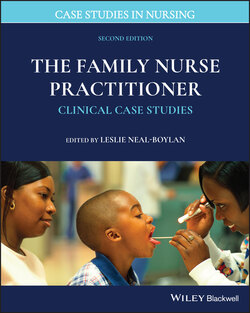Читать книгу The Family Nurse Practitioner - Группа авторов - Страница 40
ОглавлениеCase 4.9 Gastrointestinal Complaint
By Allison Grady, MSN, APNP
SUBJECTIVE
Seven‐year‐old Katie presents with new onset gastrointestinal complaints. She has no significant past medical history and no known allergies. She was recently seen in her primary care provider’s office for a well‐child check. It was noted that her growth curve had plateaued for the past 2 years and she is now “falling off” her curve. Her mother describes Katie as a “classic picky eating toddler” who, in the past 2 years, has begun expanding list of acceptable foods. In the past several months, the mother has noticed that Katie has had increased incidences of diarrhea and abdominal pain. It has interfered in her ability to attend school and she is missing approximately 3 days per month due to symptoms. Her diarrhea is not accompanied by fever, upper respiratory infection (URI) symptoms, or vomiting. No one else in the house has experienced similar complaints.
Birth history: Katie was born at 38 weeks’ gestation via spontaneous vaginal delivery. She weighed 7 lbs, 7 oz and required no NICU placement.
Social history: Katie is in second grade and lives with her mother and father. Katie does well in school and is easily able to name friends and her favorite subject. Katie has a 5‐year‐old sister, Madison. The family owns their own home in a suburb. They have 2 dogs.
Diet: Katie is described as a “reformed picky eater” by her mother. She eats steak and chicken for meat (refuses fish); flavored yogurt and cheese are her main sources of calcium; her favorite foods are turkey sandwiches, goldfish crackers, and pasta. Katie does not drink juice or soda. She has 3–5 servings of fruits or vegetables per day.
Elimination: Stools daily and these are described as soft and non‐painful to pass. As noted by her mother, Katie has been experiencing greater frequency of diarrhea (1–3 times per week) which her mother describes as frequent, very loose, and malodorous. Katie urinates several times per day and denies any pain with urination. She has no history of urinary tract infection (UTI).
Sleep: Katie goes to bed at 8 p.m. and wakes up between 6:30 and 7 a.m. She generally sleeps through the night and sleeps alone in her own bed. Her mother reports that Katie has occasionally awakened during the night to stool.
Family history: Katie’s mother reports a history of multiple miscarriages, and her father has a history of high cholesterol (on medication). Her maternal aunt has a history of celiac disease. Her maternal grandmother has a history of colorectal cancer (deceased). Her paternal grandfather has Type 1 diabetes.
Medications: Katie takes a multivitamin daily.
Allergies: Katie has no known allergies.
OBJECTIVE
General: Katie is a 7‐year‐old feminine appearing child who presents in no acute distress. She is interactive and age‐appropriate in her responses.
Vital signs: Heart rate is 90; respiratory rate is 14; blood pressure is 95/55, oxygen saturation is 100% on room air; pain is rated as a 0.
HEENT: Normocephalic; thick brown hair; eyes slightly sunken; tympanic membranes visible and with no evidence of effusion/infection; nostrils patent; trachea is midline. There is no evidence of enlarged thyroid.
Mouth: Mucous membranes with thick saliva. Mild enamel erosion on teeth. Dentition reveals mix of primary and secondary teeth.
Cardiac: Heart with regular rate and rhythm. There is no murmur noted.
Respiratory: Lungs are clear to auscultation bilaterally. There is equal air movement in all lobes.
Abdomen: Abdomen is soft, mildly tender to palpation. There is intermittent guarding in the right upper quadrant. Normoactive bowel sounds are present throughout. There are no masses or hepatosplenomegaly appreciated.
Genitourinary: Tanner stage 2 external female genitalia. There are no anal or rectal fissures, tags, or hemorrhoids.
Neuromusculoskeletal: Moves all 4 extremities equally with appropriate strength.
Neurologic: Alert and oriented to person, place, time, situation. Cranial nerves are grossly intact.
Psychological: Not visibly anxious or agitated.
CRITICAL THINKING
1 What are the three most likely differential diagnoses for this patient? What tests would help to confirm your suspicions?
2 What other information gathered through noninvasive methods would help to confirm the diagnosis?
3 What information from the family history helps to guide your differentials?
4 Once the diagnosis is established, what other multidisciplinary support would you offer the patient and family? What other medical specialties/subspecialties would you engage?
